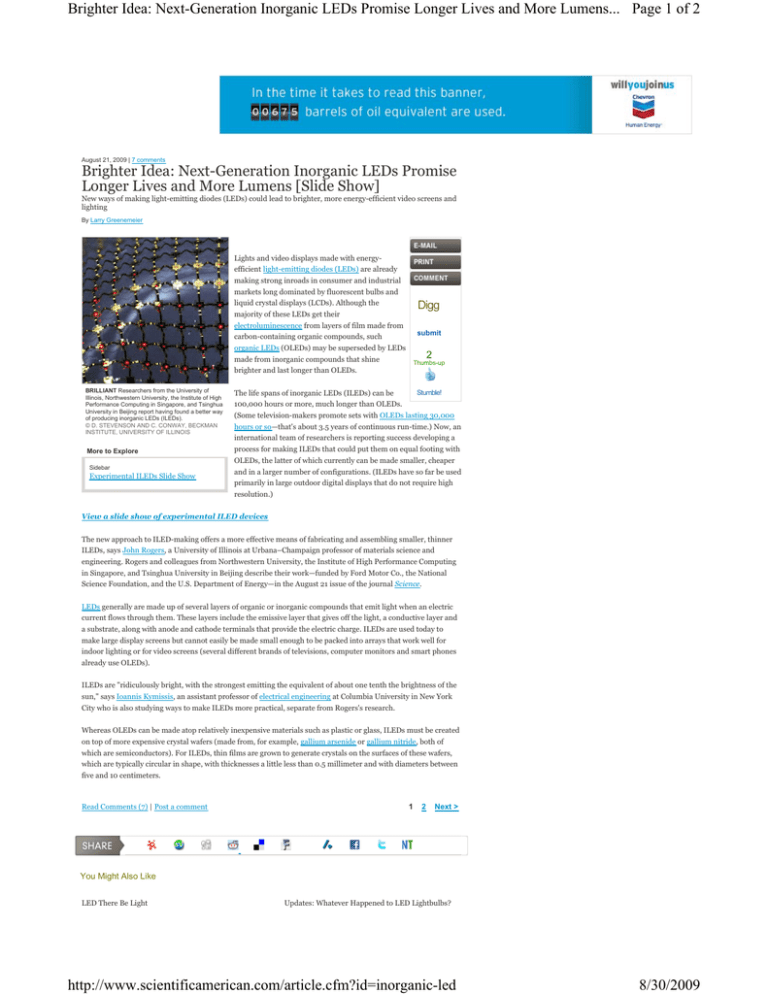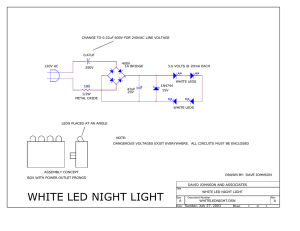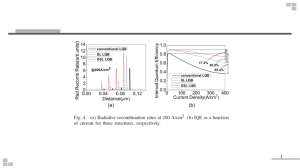
Brighter Idea: Next-Generation Inorganic LEDs Promise Longer Lives and More Lumens... Page 1 of 2
August 21, 2009 | 7 comments
Brighter Idea: Next-Generation Inorganic LEDs Promise
Longer Lives and More Lumens [Slide Show]
New ways of making light-emitting diodes (LEDs) could lead to brighter, more energy-efficient video screens and
lighting
By Larry Greenemeier
Lights and video displays made with energyefficient light-emitting diodes (LEDs) are already
making strong inroads in consumer and industrial
markets long dominated by fluorescent bulbs and
liquid crystal displays (LCDs). Although the
majority of these LEDs get their
electroluminescence from layers of film made from
carbon-containing organic compounds, such
organic LEDs (OLEDs) may be superseded by LEDs
made from inorganic compounds that shine
brighter and last longer than OLEDs.
BRILLIANT Researchers from the University of
Illinois, Northwestern University, the Institute of High
Performance Computing in Singapore, and Tsinghua
University in Beijing report having found a better way
of producing inorganic LEDs (ILEDs).
© D. STEVENSON AND C. CONWAY, BECKMAN
INSTITUTE, UNIVERSITY OF ILLINOIS
More to Explore
Sidebar
Experimental ILEDs Slide Show
Digg
submit
2
Thumbs-up
Stumble!
The life spans of inorganic LEDs (ILEDs) can be
100,000 hours or more, much longer than OLEDs.
(Some television-makers promote sets with OLEDs lasting 30,000
hours or so—that's about 3.5 years of continuous run-time.) Now, an
international team of researchers is reporting success developing a
process for making ILEDs that could put them on equal footing with
OLEDs, the latter of which currently can be made smaller, cheaper
and in a larger number of configurations. (ILEDs have so far be used
primarily in large outdoor digital displays that do not require high
resolution.)
View a slide show of experimental ILED devices
The new approach to ILED-making offers a more effective means of fabricating and assembling smaller, thinner
ILEDs, says John Rogers, a University of Illinois at Urbana–Champaign professor of materials science and
engineering. Rogers and colleagues from Northwestern University, the Institute of High Performance Computing
in Singapore, and Tsinghua University in Beijing describe their work—funded by Ford Motor Co., the National
Science Foundation, and the U.S. Department of Energy—in the August 21 issue of the journal Science.
LEDs generally are made up of several layers of organic or inorganic compounds that emit light when an electric
current flows through them. These layers include the emissive layer that gives off the light, a conductive layer and
a substrate, along with anode and cathode terminals that provide the electric charge. ILEDs are used today to
make large display screens but cannot easily be made small enough to be packed into arrays that work well for
indoor lighting or for video screens (several different brands of televisions, computer monitors and smart phones
already use OLEDs).
ILEDs are "ridiculously bright, with the strongest emitting the equivalent of about one tenth the brightness of the
sun," says Ioannis Kymissis, an assistant professor of electrical engineering at Columbia University in New York
City who is also studying ways to make ILEDs more practical, separate from Rogers's research.
Whereas OLEDs can be made atop relatively inexpensive materials such as plastic or glass, ILEDs must be created
on top of more expensive crystal wafers (made from, for example, gallium arsenide or gallium nitride, both of
which are semiconductors). For ILEDs, thin films are grown to generate crystals on the surfaces of these wafers,
which are typically circular in shape, with thicknesses a little less than 0.5 millimeter and with diameters between
five and 10 centimeters.
Read Comments (7) | Post a comment
1
2
Next >
You Might Also Like
LED There Be Light
Updates: Whatever Happened to LED Lightbulbs?
http://www.scientificamerican.com/article.cfm?id=inorganic-led
8/30/2009
Brighter Idea: Next-Generation Inorganic LEDs Promise Longer Lives and More Lumens... Page 2 of 2
Today, Compact Fluorescents-Tomorrow, LED Bulbs?
The Future of Lighting Is Already on
Your Christmas Tree
Ultra-efficient Organic LED
Outshines Lightbulb
Discuss This Article
Ads by Google
Led Lighting guide
Looking to find Led Lighting?
See our Led Lighting guide.
UsMilitarySurplus.com
Energy Efficient Lighting
Save Big on Energy with Energy Star
Discounted + 10%Coupon Code "Inaug"
www.theenergyconscious.com
Save With LED Lighting
Save up to 90% on your lighting
bills by using LED lamps
www.ecolumina.com
Best Deal on LED Signs
LED Signs for your Business
High Quality 100% Satisfaction
www.eloofaimports.com/LED-Sign
© 1996-2009 Scientific American Inc. All Rights Reserved. Reproduction in whole or in part without permission is prohibited.
ADVERTISEMENT
http://www.scientificamerican.com/article.cfm?id=inorganic-led
8/30/2009
Brighter Idea: Next-Generation Inorganic LEDs Promise Longer Lives and More Lumens... Page 1 of 2
August 21, 2009 | 7 comments
Brighter Idea: Next-Generation Inorganic LEDs Promise
Longer Lives and More Lumens [Slide Show]
New ways of making light-emitting diodes (LEDs) could lead to brighter, more energy-efficient video screens and
lighting
By Larry Greenemeier
ILED wafers cannot be reused because the normal process is to saw apart the newly formed ILED crystals—while
also cutting through the underlying wafer. (OLEDs have always been able to reuse their substrates, one of the
reasons they have cost less than ILEDs.) After the ILED crystals have been separated they are picked up by a
robotic device so they can be packaged, wired and used as tiles to make jumbotrons and other large, mostly
outdoor displays. The robotic device is unable to pick up crystals that are smaller than about 100 microns per side,
which prevents ILEDs from being made smaller.
The process that Rogers and his colleagues described in their research uses a different approach to cutting apart
and transferring the ILED crystals. "We've found a way to take the inorganic material you grow on the wafer and
embed a sacrificial base," he says. The researchers then make a lithographic imprint on the newly formed crystals.
Instead of using a saw or a robotic "picker," the researchers use a rubber stamp to separate and lift the individual
crystals—which in this new process can be as small as 20 microns on each side—so they can be arranged in tight
arrays on glass, plastic, rubber or other surfaces. The underlying wafer can now be reused. (A micron is one
millionth of a meter, or about 40 millionths of an inch.)
With this new process, the ILEDs can be interconnected, much the way OLEDs are wired, which saves space. "It's
not the individual wiring that's done with ILEDs today," Rogers says.
It's unclear exactly how much of a cost difference there will be between OLEDs and ILEDs if they are used in
comparable devices such as televisions or computer monitors. Even though ILEDs cost more to make, Kymissis
says, "because they're so bright, you don't need as many."
Ford funded the research in part as a way to develop flexible lighting for vehicle interiors and brake lights,
although, according to Rogers, it will be at least a couple of years before his team's technology would be ready for
commercial use.
Read Comments (7) | Post a comment
< Prev
1
2
You Might Also Like
LED There Be Light
Updates: Whatever Happened to LED
Lightbulbs?
Today, Compact Fluorescents-Tomorrow, LED Bulbs?
The Future of Lighting Is Already on
Your Christmas Tree
Ultra-efficient Organic LED
Outshines Lightbulb
Discuss This Article
http://www.scientificamerican.com/article.cfm?id=inorganic-led&page=2
8/30/2009
Brighter Idea: Next-Generation Inorganic LEDs Promise Longer Lives and More Lumens... Page 2 of 2
© 1996-2009 Scientific American Inc. All Rights Reserved. Reproduction in whole or in part without permission is prohibited.
ADVERTISEMENT
http://www.scientificamerican.com/article.cfm?id=inorganic-led&page=2
8/30/2009


